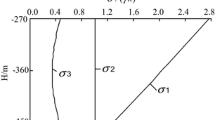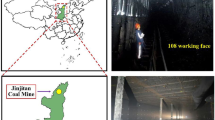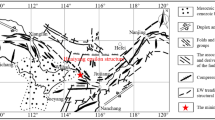Abstract
The regular pattern of surface deformation and the mechanism of underground strata movement, especially in iron mines constructed with the block caving method, have a great influence on infrastructure on the surface, so they are an important topic for research. Based on the engineering geology conditions and the surface deformation and fracture features in Chengchao Iron Mine, the mechanism of strata movement and the regular pattern of surface deformation in the footwall were studied by the geomechanical method, and the following conclusions can be drawn: I. The surface deformation process is divided into two stages over time, i.e., the chimney caving development stage and the post-chimney deformation stage. Currently, the surface deformation in Chengchao Iron Mine is at the post-chimney deformation stage. II. At the post-chimney deformation stage, the surface deformation and geological hazards in Chengchao Iron Mine are primarily controlled by the NWW-trending joints, with the phenomenon of toppling deformation and failure on the surface. Based on the surface deformation characteristics in Chengchao Iron Mine, the surface deformation area can be divided into the following four zones: the fracture extension zone, the fracture closure zone, the fracture formation zone and the deformation accumulation zone. The zones on the surface can be determined by the surface deformation characteristics. III. The cantilever beams near the chimney caving area, caused by the NWW-trending joints, have been subjected to toppling failure. This causes the different deformation and failure mechanisms in different locations of the deep rock mass. The deep rock can be divided into four zones, i.e., the fracture zone, fracture transition zone, deformation zone and undisturbed zone, according to the different deformation and failure mechanisms. The zones in the deep rock are the reason for the zones on the surface, so they can be determined by the zones on the surface. Through these findings, the degree of damage to the infrastructure in different locations can be determined based on the surface deformation zones. As the mining continues deeper, the development regulation of the zones on the surface and in deep rock mass can be further studied based on the zones in the deep rock.


















Similar content being viewed by others
Abbreviations
- p i :
-
Normal force
- η :
-
Stress equivalent coefficient
- \( \bar{h}_{i} \) :
-
Average height of the cantilever beam
- h i :
-
Height of the cantilever beam at side i
- X i :
-
Length from the position of tensile failure to position P i at side i
- T i :
-
Tangential force at side i
- μ i :
-
Coefficient of friction
- t i :
-
Thickness of the cantilever beam
- I i :
-
Momentum of inertia
- S i :
-
Tangential component of gravity
- N i :
-
Normal component of gravity
- A i :
-
Cross-sectional area of cantilever beam
- W i :
-
Gravity of cantilever beam
- σ t :
-
Tensile strength of the cantilever beam
- K :
-
Lateral pressure coefficient
- γ :
-
Unit weight of material
- α :
-
Cantilever beam dip angle
- φ i :
-
Joint friction angle
- σ 1 :
-
Maximum principal stress of the in situ stress
- σ 2 :
-
Intermediate principal stress of the in situ stress
- σ 3 :
-
Minimum principal stress of the in situ stress
- H :
-
Depth from the surface
- D :
-
Mining depth
- i :
-
Number of the cantilever beam
References
Adhikary DP, Dyskin AV, Jewell RJ, Stewart DP (1997) A study of the mechanism of flexural toppling failure of rock slopes. Rock Mech Rock Eng 30(2):75–93
Atkinson J, Brown E, Potts M (1975) Collapse of shallow unlined tunnels in dense sand. Tunn Tunn 7(3):81–87
Aydan APDÖ, Kawamoto T (1999) The stability of slopes and underground openings against flexural toppling and their stabilisation. Rock Mech Rock Eng 25(3):143–165
Bai WW (2010) Study on the ground movement and deformationof affiliated architecture in eastern area of Cheng-chao iron mine. Ph.D. Thesis, Chinese Academy of Sciences, Wu Han, China
Bai YR, Gu ZM, Bai SW (2002) Primary study on ground surface subsidence and rockmass movement in east area of Chengchao Iron due to underground mining. Chin J Rock Mech Eng 21(3):340–342
Baldi P, Casula G, Cenni N, Loddo F, Pesci A (2009) GPS-based monitoring of land subsidence in the Po Plain (Northern Italy). Earth Planet Sci Lett. 288(1):204–212
Bian HF, Zhang SB, Zhang QZ, Zheng NS (2014) Monitoring large-area mining subsidence by GNSS based on IGS stations. Trans Nonferrous Met Soc China 24(2):514–519
Boyum, B. H. 1961. Subsidence case histories in Michigan mines. In: Paper presented at The 4th US Symposium on Rock Mechanics (USRMS)
Brown ET (2002) Block caving geomechanics. Julius Kruttschnitt Miner Res Cent, Brisbane
Brown ET, Ferguson GA (1979) Prediction of progressive hanging-wall caving, Gaths mine, Rhodesia. Trans Inst Min Metall Sect A Min Ind 88((JUL)):A92–A105
Chen CX, Xiao GF, Wei LD (2007) The Research Report on the Rock Stability and structure safety of eastern main shaft and west well in Chengchao Iron: Wuhan Institute of rock and soil mechanics. Chin Acad Sci, Wuhan
Chen CX, Xiao GF, Huang PL (2010) The feasibility study report of the extended use of eastern main shaft and west well in Chengchao Iron: Wuhan Institute of rock and soil mechanics. Chin Acad Sci, Wuhan
Chen CX, Xiao GF, Huang PL (2011) The report on monitoring and prediction of surface deformation caused by mining in Chengchao Iron: Wuhan Institute of rock and soil mechanics. Chin Acad Sci, Wuhan
De Bruyn, I. A., Bell, F. G., Jermy, C. A. 2000. The problem of sinkhole formation in two dolomite areas of South Africa. In: Paper presented at the ISRM international symposium
Fang JP, Peng ZB, Yan RG (2004) The law of tectonic stress mining ground surface subsidence and its engineering treatment method. J Cent South Univ Technol (Nat Sci) 35(3):506–510
Hoek E (1974) Progressive caving induced by mining an inclined orebody. Trans Inst Min Metall Sect A Min Ind 83:A133–A139
Huang PL (2008) Study on rock movement caused by underground mining in tectonic stress-mines. Ph.D. Thesis, Chinese Academy of Sciences, Wu Han, China
Jennings JE, Brink ABA, Louw A, Gowan GD (1965) Sinkholes and subsidences in the Transvaal dolomites of South Africa. In: Paper presented at the proceedings of 6th international conference soil mechanics
Kang JR (2008) Analysis of effect of fissures caused by underground mining on ground movement and deformation. Chin J Rock Mech Eng 27(1):59–64
Li JC (2013) Study on rock movement caused by goaf roof in tectonic stress-mines. Ph.D. Thesis, Jiangxi University of Science and Technology, Gan zhou, China
Li WX, Mei SH, Zhai SH, Qiao JL, Zhao ST, Liang XL (2004) Analysis on in situ stress field change due to underground mining of metal ore and its influence on range of rock mass displacements. Chin J Rock Mech Eng 23(23):4047–4051
Lin J (2009) Surface deformation analysis and forecast study of the underground mining mine based on GPS monitoring. Ph.D. Thesis, Chinese Academy of Sciences, Wu han, China
Liu C, Zhou F, Gao J, Wang J (2012) Some problems of GPS RTK technique application to mining subsidence monitoring. Int J Min Sci Technol 22(2):223–228
Lu HF, Liu QS, Chen CX (2012) Improvement of cantilever beam limit equilibrium model of counter-tilt rock slopes. Rock Soil Mech 33(2):577–584
Lupo J (1998) Large-scale surface disturbances resulting from underground mass mining. Int J Rock Mech Min Sci 35(4):399
Qian MG (1982) A study of the behaviour of overlying strata in longwall mining and its application to strata control. Dev Geotech Eng 32:13–17
Qian MG, Liu XX, Xu JL (2000) Key strata theory of strata control: China University of Mining and Technology, Xuzhou
Rice GS (1934) Ground movement from mining in Brier Hill mine, Norway, Michigan. Min Metall 15(325):12–14
Song ZQ (1988) Practical mine pressure and control. China University of Mining and Technology, Beijing
Sun GZ (1988) The structural mechanics of rock mass. Science Press, Beijing
Van As A, Davison J, Moss A (2003) Subsidence definitions for block caving mines. Rio Tinto technical services
Wang J, Peng XG, Xu CH (2011) Coal mining GPS subsidence monitoring technology and its application. Min Sci Technol 21(4):463–467
Wang X, Kulatilake PHSW, Song WD (2012) Stability investigations around a mine tunnel through three-dimensional discontinuum and continuum stress analyses. Tunn Undergr Space Technol 32(32):98–112
Xi RS, Chen CX (2011) Study of influence of discontinuities on rock movement and surface deformation in eastern area of Chengchao iron mine. Rock Soil Mech 32(2):532–537
Zhu JQ (1999) Primary analysis on geological hazard in the eastern area of Chenchao iron mine. Chin J Rock Mech Eng 18:497–502
Acknowledgements
This research work was supported by the National Key Basic Research Development Plan (973) (Grant Nos. 2014CB047100 and 2011CB013500) and the Chinese National Natural Science Foundation (Grant No. 51279024).
Author information
Authors and Affiliations
Corresponding author
Rights and permissions
About this article
Cite this article
Cheng, G., Chen, C., Ma, T. et al. A Case Study on the Strata Movement Mechanism and Surface Deformation Regulation in Chengchao Underground Iron Mine. Rock Mech Rock Eng 50, 1011–1032 (2017). https://doi.org/10.1007/s00603-016-1132-8
Received:
Accepted:
Published:
Issue Date:
DOI: https://doi.org/10.1007/s00603-016-1132-8




